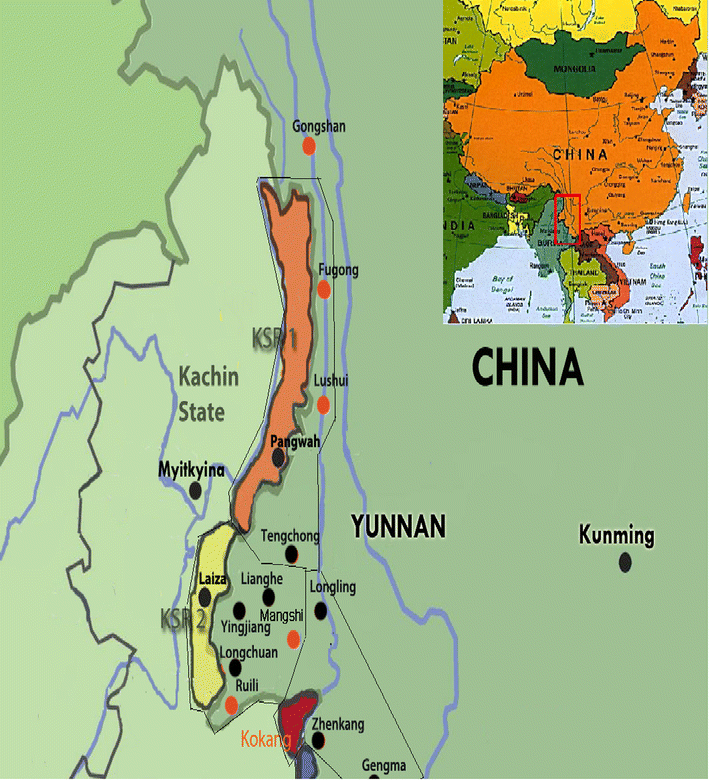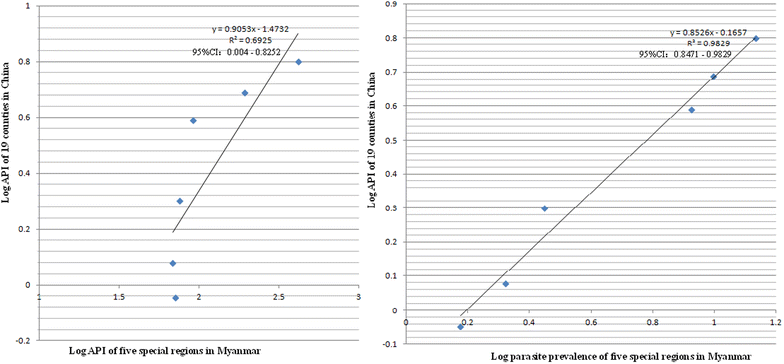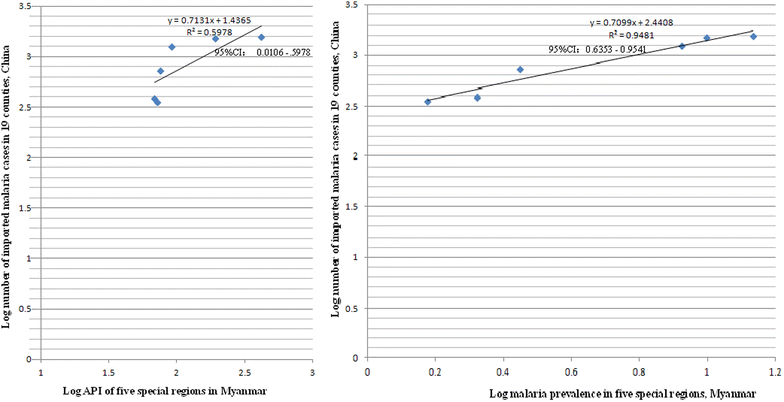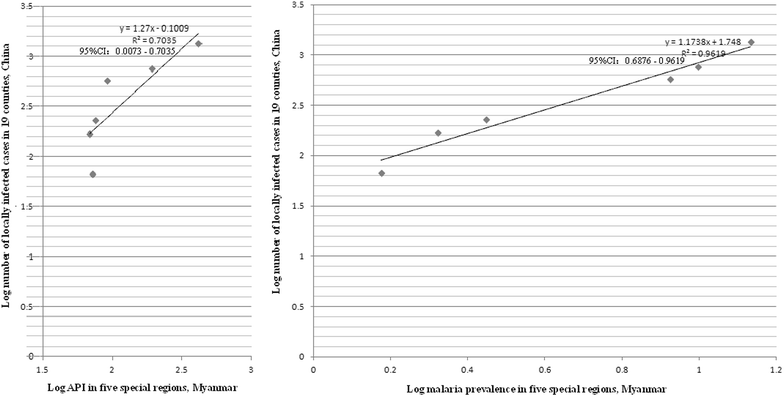The relationship of malaria between Chinese side and Myanmar's five special regions along China-Myanmar border: a linear regression analysis
- PMID: 27430217
- PMCID: PMC4949750
- DOI: 10.1186/s12936-016-1413-4
The relationship of malaria between Chinese side and Myanmar's five special regions along China-Myanmar border: a linear regression analysis
Abstract
Background: Understanding malaria along the international border of two countries is important for malaria control and elimination; however, it is difficult to investigate a quantitative relationship between two countries' border areas due to a shortage of malaria surveillance data.
Methods: A linear regression analysis was conducted to investigate the logarithmic annual parasite incidence (API), numbers of imported cases and local infections in 19 Chinese border counties, with logarithmic API and parasitic prevalence in Myanmar's five special regions.
Results: API in 19 Chinese counties was stronger correlated with parasite prevalence than with API in five special regions of Myanmar, correlation coefficient (R) 0.8322 (95 % CI 0.0636-0.9084) versus 0.9914 (95 % CI 0.9204-0.9914). Numbers of imported malaria cases and local malaria infections in 19 Chinese counties were also closer correlated with parasite prevalence than with API in five special regions of Myanmar.
Conclusions: There is a strong correlation of malaria between China's side and Myanmar's side along the international border. Parasite prevalence is a better indicator of the true malaria situation in a setting without sound surveillance and reporting system. China should reconsider its definition of imported malaria which neglects imported malaria by mosquitoes and asymptomatic parasite carriers.
Keywords: Chinese-Myanmar border; Linear regression analysis; Malaria.
Figures




Similar articles
-
From control to elimination: a spatial-temporal analysis of malaria along the China-Myanmar border.Infect Dis Poverty. 2020 Nov 19;9(1):158. doi: 10.1186/s40249-020-00777-1. Infect Dis Poverty. 2020. PMID: 33213516 Free PMC article.
-
Malaria control along China-Myanmar Border during 2007-2013: an integrated impact evaluation.Infect Dis Poverty. 2016 Aug 10;5(1):75. doi: 10.1186/s40249-016-0171-4. Infect Dis Poverty. 2016. PMID: 27507163 Free PMC article.
-
[Malaria elimination strategy and joint prevention and control of malaria across China-Myanmar border areas: an overview].Zhongguo Xue Xi Chong Bing Fang Zhi Za Zhi. 2025 Feb 27;37(1):19-23. doi: 10.16250/j.32.1915.2024281. Zhongguo Xue Xi Chong Bing Fang Zhi Za Zhi. 2025. PMID: 40235373 Review. Chinese.
-
Risk assessment of malaria in land border regions of China in the context of malaria elimination.Malar J. 2016 Nov 8;15(1):546. doi: 10.1186/s12936-016-1590-1. Malar J. 2016. PMID: 27825379 Free PMC article.
-
Development of Malaria Digital Archives in Myanmar Through Official Development Assistance and Their Narrative Review.Pathogens. 2025 May 14;14(5):481. doi: 10.3390/pathogens14050481. Pathogens. 2025. PMID: 40430801 Free PMC article. Review.
Cited by
-
Malaria from hyperendemicity to elimination in Hekou County on China-Vietnam border: an ecological study.Malar J. 2017 Feb 7;16(1):66. doi: 10.1186/s12936-017-1709-z. Malar J. 2017. PMID: 28173802 Free PMC article.
-
Intensive surveillance, rapid response and border collaboration for malaria elimination: China Yunnan's ''3 + 1''strategy.Malar J. 2021 Oct 9;20(1):396. doi: 10.1186/s12936-021-03931-8. Malar J. 2021. PMID: 34627264 Free PMC article. Review.
-
Genomic Epidemiology of Antimalarial Drug Resistance in Plasmodium falciparum in Southern China.Front Cell Infect Microbiol. 2021 Jan 8;10:610985. doi: 10.3389/fcimb.2020.610985. eCollection 2020. Front Cell Infect Microbiol. 2021. PMID: 33489939 Free PMC article.
-
The health beliefs, dengue knowledge and control behaviors among internally displaced persons versus local residents in Kachin Special Region II, Myanmar.PLoS Negl Trop Dis. 2020 Jun 25;14(6):e0008321. doi: 10.1371/journal.pntd.0008321. eCollection 2020 Jun. PLoS Negl Trop Dis. 2020. PMID: 32584822 Free PMC article.
-
Treatment-seeking behaviours of malaria patients versus non-malaria febrile patients along China-Myanmar border.Malar J. 2023 Oct 14;22(1):309. doi: 10.1186/s12936-023-04747-4. Malar J. 2023. PMID: 37833761 Free PMC article.
References
-
- WHO . World malaria report 2015. Geneva: World Health Organization; 2015.
-
- WHO . Global technical strategy for malaria 2016–2030. Geneva: World Health Organization; 2015.
-
- WHO . Strategy for malaria elimination in the Greater Mekong Subregion: 2015–2030. Geneva: World Health Organization; 2015.
-
- Ministry of Health, People’s Republic of China . Malaria elimination action plan 2010–2020. Beijing: The Ministry; 2010.
Publication types
MeSH terms
LinkOut - more resources
Full Text Sources
Other Literature Sources
Medical

